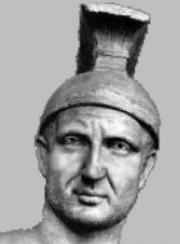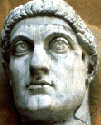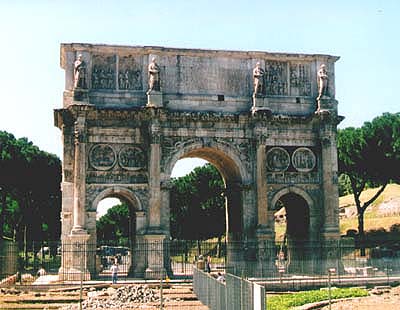|
|
 |
|
Enter into the underground... |
|
written
by calaroni / 09.08.2004 |
|
|
| |
Introduction |
| |
| |

|
|
| Pliny the Younger |
| Renaissance statue of Pliny the Younger. |
| |
|
| |

|
|
| Emperor Decius |
| Emperor Decius persecuted Christians to please the Roman gods, to restore order, and to rescue the Empire from economic ruin |
| |
|
| |

|
|
| Emperor Diocletian's persecutions |
| An illustration by Elisabeth Jvanovsky depicting Diocletian persecuting the Christians. |
| |
|
| |

|
|
| Statue of Emperor Constantine |
|
| |
|
| |

|
|
| Arch of Constantine |
| The Arch of Constantine was dedicated in AD 315 to honor Constantine's victory over Maxentius in the Battle of the Mulvian Bridge. |
| |
|
Enter into the underground. Indulge yourself in the creation of a new religion, in the makings of history itself. Over six million burial sites, including sixty catacombs, are scattered across the Roman world; six million small glimpses into early Christianity. How did the Roman Empire switch so drastically from a land of tolerant, polytheistic paganism to the thriving center of Roman Catholicism? How did Christianity, a quiet and newly emerging cult in the second century survive the clash of religious beliefs and triumph over all, becoming the official religion of the Roman Empire?
The Rise of Christianity:
Up until and during the rule of Caesar, the Roman Empire was overwhelmingly pagan and polytheistic. The pagan views were tolerant of other believers’ gods as there could be a god for anything. The Roman Empire was also tolerant of the beliefs of the people as long as everyone performed their civic duty to sacrifice to the gods and to the emperor. No one took much notice of what the people truly believed and if the people of Rome had true faith in their gods.
Through the first century, Christianity had been considered a bizarre sect of Judaism. To Romans, religion was ancient. During this time, Christianity was nothing but new, and thus, pagan and Jewish Romans refused to recognize Christianity as its own religion. Instead, it was considered nothing but superstition, and superstitions were to be avoided.
Following their beliefs, early Christians refused to sacrifice and worship the Roman gods and emperor, as they chose to worship their only god. This was not acceptable to the Roman emperor, as such Christians were criminals for not paying homage to him. In AD 112, Pliny the Younger, a respected official of the Roman province of Bithynia, wrote a letter to the Roman emperor as to how he should punish Christians. Pliny witnessed that the Christians brought before him seemed to be harmless, kind people; yet he felt obligated to execute those who insisted on remaining Christian, even after he warned them. Those who did deny they were Christians, he discharged. The emperor replied that Pliny should not hunt out the Christians, but that he would still have to deal with those who were accused as Christians. Even if the accused were Christian, the emperor said they should be released if they agreed to stop. Such events took place throughout the Roman Empire as officials were perplexed by the harmless ways of the Christians. The historical significance of Pliny the Younger is the recognition by Pliny and the emperor that Christians were a separate group, no longer lumped together with Jews.
Because Judaism had existed in Rome for years, Jews had a legal agreement with the Empire that Jews were exempt from participating in the civic pagan rituals. Now that Christians were no longer considered a direct sect of Judaism, their lack of participation in public sacrifices, rituals, and festivals made them seem antisocial and a threat to the Roman gods and the Empire itself. Christianity conflicted with the tolerant ways of Paganism as its members were forbidden to worship anything but the one Christian God. Michael White, in his discussion of the absence of Christians in the Roman world, writes: "With a few key exceptions, this is where the Christians become more noticeable to their pagan neighbors. They don't go to the temples. On important feast days when it would be customary to offer sacrifices on behalf of the health of the emperor and on behalf of the health of the state. The Christians probably would have viewed these ritual performances as incompatible with their belief in the one true God. So Christians would have been on those occasions conspicuous by their absence." Although Christians did not participate in many of the public rituals of Rome, they were typically law-abiding, good citizens, creating a confusing contradiction, as witnessed by Pliny the Younger.
As Christianity became more popular, Christians became more conspicuously absent from the public religious sphere. In time, they became the scapegoat for all things bad; because they did not perform their civic duty of worshiping the Roman gods, they were blamed for everything from plagues to drought to bad crops. It was to the point, in the second century, that Christians were forced to either sacrifice to the emperor or sacrifice their lives. During this time of persecution, arenas like the Colosseum, which were once used to execute convicted criminals, were now used to torture and execute convicted Christians.
During this time, institutions began developing in some churches across Rome. In AD 250, the Christian religion had grown so large that they needed widespread organization. As this new religion grew, Roman rulers felt their power slipping away. Emperor Decius felt that Christianity was a threat to the Empire and made the decision that Christians must be dealt with in a large-scale effort. Anyone accused of being Christian was imprisoned. Anyone who performed public sacrifices was given a Chit, a ticket as supposed proof of being non-Christian. In AD 300, Emperor Diocletian tried to get all Christian high officials out of office, but failed because Christians were some of the few who could read, due to the Bible. In the late 3rd century, the numbers of Christians had risen so high that it was impossible to eradicate them.
The early 4th century marked a dramatic shift for the Roman Empire and for the history of Christianity. It was during this time that Roman General Constantine, born in 285, the sun-worshiping head of an army, had a vision that a cross appeared on the sun with an inscription saying “By this, conquer.” Following his vision, Constantine entered the Battle of the Mulvian Bridge with a cross painted on each soldier’s shield, won the battle, and became emperor. Having won victory using Jesus’ name, Constantine, in partnership with Emperor Licinius of the eastern provinces, granted freedom to all Christians in 313 and returned the property and worshiping rights taken from them during the persecutions. He then gave governmental funds and support to the Christians for the building of churches and basilicas and for the copying of scriptures. Christians worshiped freely with the support of the new emperor and Christianity became part of Imperial Rome and the politics of the Empire. Due to the deep pagan roots of Rome, Constantine could not fully convert Rome to Christianity, so he moved the capital of the Roman Empire from Rome to Byzantium, which became known as Constantinople.
During his rule, Constantine called for unity in Christian teaching and beliefs; he persecuted those with differing beliefs. By starting one single unified church, the Christian Church officially became a partner with the Roman Empire.
The history of the catacombs themselves is included in the following section (II).
|
| |
|
| |
|
|
 |
|





